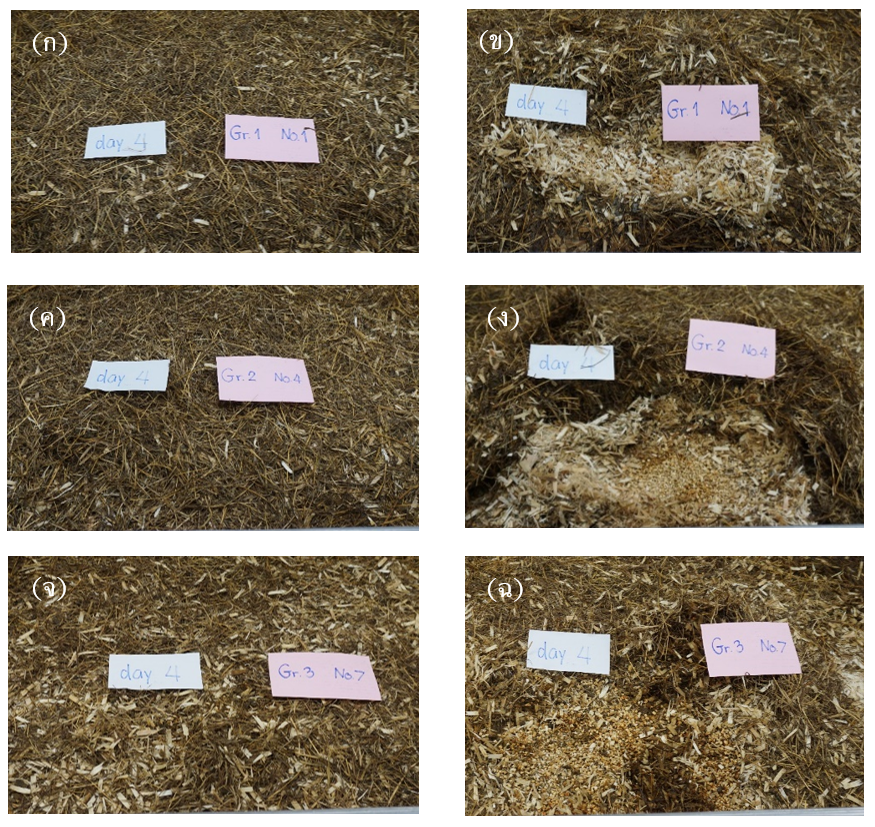The Study on Suitable Ratios of Mixed Bedding Materials (Aspen Shavings and Corn cob) for 7-Day Cage Replacement in Mlac:DH Colony of National Laboratory Animal Center, Mahidol University
Keywords:
Bedding Materials, Ratio, Bedding Replacement, Mlac:DH Guinea PigAbstract
The purpose of this study was to study the ratio of using two types of bedding materials, namely aspen shavings and corncob. Group 1 aspen shavings were more than corncob (2:1), Group 2 aspen shavings were equal to corncob (1:1), and Group 3 aspen shavings were less than corncob (1:2). The Mlac:DH guinea pig breeders were kept on mixed bedding for each group for 7 consecutive days to simulate the 7-day cage replacement period. Feed consumption, water consumption, and waste weight were collected every day. Pictures of the bedding and cleanliness of the animals' bellies were collected on days 4 and 7. Carbon dioxide (CO2) and ammonia (NH3) gases were measured within the animal cages daily from day 4 to day 7. It was found that the condition of all groups on the 7th day showed no difference in the accumulated waste. The cleanliness of the animal was determined by fecal smears under the belly or the appearance of clumped hair. It was found that all three groups (both males and females) had no feces on the abdominal hair and no clumped hair after 4 and 7 days. All three groups did not differ from each other. The daily food consumption and the amount of waste in each group were not statistically different. Each group's CO2 and NH3 levels were within the acceptable range and were not significantly different. The water consumption of all groups was higher than the average normal water consumption of young adult guinea pigs, and the water consumption of Group 3 was significantly different from Group 1and Group 2. However, this excessive water consumption could be due to the water-play behavior of guinea pigs. For the condition of the surface of the rearing cage at the 7-day rearing, Group 1 had a higher ratio of aspen shavings than corncob, and there was more wetness accumulation than in Groups 2 and 3 because it had less adsorbent. Group 3, which has the highest corncob ratio, was the group that could absorb the most moisture. However, based on the surface texture of the bedding material after the 7-day rearing period, it was found that the corncobs were pushed up to mix in the foreground more than Groups 1 and 2 which could be a factor causing foot injury. This is considered adversely beneficial to animal health and welfare. Thus, it was concluded that the bedding mixture of Group 2 (aspen shavings equal to corncobs) was more effective than the other two groups for housing Mlac:DH guinea pig bloodstocks at the 7-day cage replacement. However, further studies were needed to carried out the effect of long-term rearing on the 7-day cage replacement.
References
Nation Research Council. Guide for the Care and Use of Laboratory Animals. 8th ed. Washington DC, USA: The National Academic Press; 2011.
IBM Corp. IBM SPSS Statistics for Windows, Version 27.0. Armonk, NY: IBM Corp; 2020.
Burn CC, Mason GJ. Absorbencies of six different rodent beddings: Commercially advertised absorbencies are potentially misleading. Laboratory Animals 2005;39:68-74.
Kengkoom K, Ampawong S, Laosantisuk A, Kaewmanee W. Absorbency and physical properties of three different rodent beddings in Thailand. Kasetsart Journal Natural Science 2008;42:463-72.
Brown C. Treatment of pododermatitis in the guinea pig. Lab Animal 2008;37(4):156-7.
Blair J. Bumblefoot. Veterinary Clinics of North America: Exotic Animal Practice 2013;16(3):715-35.
Clemons DJ, Seeman JL. The Laboratory Quinea Pig. 2nd ed. Boca Raton, FL: Taylor and Francis; 2018.
Quesenberry KE, Carpenter JW. Ferret rabbits, and rodents: clinical medicine and surgery. 3rd ed. St. Louis, Missouri: Elsevier/Saunders; 2012.

Downloads
Published
Issue
Section
License
บทความทุกบทความที่ตีพิมพ์ในวารสารการพัฒนางานประจำสู่งานวิจัย (JPR2R) ถือว่าเป็นลิขสิทธิ์ของวารสารการพัฒนางานประจำสู่งานวิจัย คณะสิ่งแวดล้อมและทรัพยากรศาสตร์ มหาวิทยาลัยมหิดล





